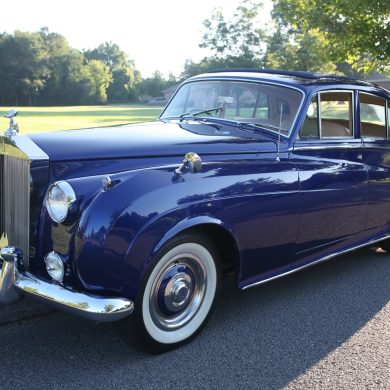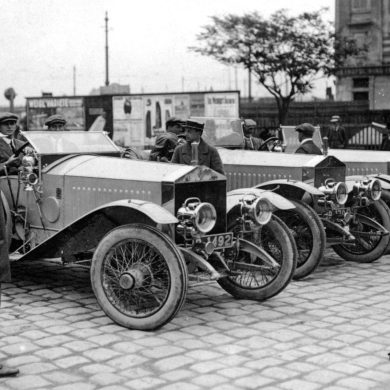The naming process for a new Rolls-Royce motor car is a crucial, painstaking, but highly important process wherein the unique heritage of the marque is greatly considered. In the current product family of Rolls-Royce, all their motor cars in their 118-year history carry a storied past: Phantom, Ghost, Dawn, and Wraith, all except the Cullinan which was named after the largest gem-quality rough diamond that was ever discovered.
In the process of naming their first battery-electric vehicle, Rolls-Royce strove to maintain and strengthen this important heritage while it also aimed to show a definitive shift into new territory as defined by innovation and progress. Rolls-Royce was able to find the perfect name in Spectre.
Rolls-Royce Motor Cars Chief Executive Officer Torsten Müller-Ötvös shared, “The advent of our first battery-electric car marks the start of a bold new era for Rolls-Royce. It is also the culmination of a long, painstaking process, in which every element in creating this landmark car has been considered in the minutest detail, over numerous iterations. But one aspect of this landmark motor car has always been certain: from the very outset, we determined that it would bear the name Spectre – the first series production Rolls-Royce ever to do so. It was a decision initially inspired by our heritage: ‘Spectre’ cars were always associated with ground-breaking technical innovations, the relentless pursuit of perfection, and a sense of mystery and otherworldliness. The motor car we now present to the world embodies all those qualities, while making the Spectre name entirely its own.”
What’s In A Name?
According to a Chinese proverb, ‘the beginning of wisdom is to call things by their right names’. It shows our innate need to classify and identify objects as a way to make sense of things in the universe. This is essentially more important when it comes to people. For our early ancestors, however, naming objects is a very important survival technique. Why do we name an inanimate object like a motor car?
The practice dates back to the creation of the motor car itself. Before the First World War, the main mode of transport was dominated by horses and horse-drawn carriages. Those who could afford a Rolls-Royce would most certainly also have and use horses. So, at the time, it was normal and even natural for them to name their new car in the same way that they would name their favorite steed.
In the keen business mind of the commercial managing director of Rolls-Royce Claude Johnson, this fundamental human trait evidently have a vast marketing potential. From 1905 to 1913, he personally came up, often with the consultation with the client, of individual names for almost 50 cars that the company produced. The most famous name given was ‘The Silver Ghost’ which was created for the 1907 London Motor Show. Motoring journalists and the general public was so impressed by the silver paintwork and silver-plated brightwork of the motor car that the moniker ‘Silver Ghost’ was eventually adopted as the official model name for all 40/50 H.P. chassis that was built until 1925, when the New Phantom was introduced.
It would certainly please Johnson to know that these ethereal, otherworldly names that was intended to capture the motor car’s characteristic of near-silent running, is still used in Rolls-Royce models, referencing the same quality more than a century later.
‘The Silver Spectre’ (Chassis 1601, 1910)
Rolls-Royce built Chassis 1601 in August 1910, which Johnson used as a trials or demonstrator car. Johnson gave it the moniker ‘The Silver Spectre’ which is the first recorded use of the Spectre name in Rolls-Royce’s archive.
In 1915, chassis 1601 was eventually sold to the War Office. The last record of the car was at a firm of motor engineers in Sheffield in 1933. During its lifetime, chassis 1601 was rebodied at least three times. This was the norm during the period and there are a lot of different reasons for this. Sometimes it is simply to follow the whim of its current owner after a change in ownership, and sometimes for more practical reasons as early coachwork used materials and methods that – though they may be suited for horse-drawn carriages doing 10 mph – might not be as appropriate for travel at 50 mph or more when used in an automobile. Though the fate of chassis 1601 is still unclear, one thing is for sure, no Rolls-Royce carried the Spectre name again for more than 20 years.
The Experimental Phantom III ‘Spectre’ Cars (1934 – 1937)
During Rolls-Royce’s early years, they were able to establish a special naming convention for their experimental cars. They gave them chassis numbers and added ‘EX’ as a suffix to make it more interesting. They started with 1EX in 1919 and went to 45EX by 1957.
These ‘large-horsepower’ development machines went through grueling test runs where they’re driven for up to 15,000 miles, and some days covering up to 800 miles through unforgiving roads in France. Even in the modern era, the EX designation is carried on, the latest of which is the 103EX electric vision vehicle which was unveiled in 2016.
It was in 1930 that Sir Henry Royce started developing a brand new V12 engine for a completely new chassis with independent front suspension. Unfortunately, his death in 1933 meant that he was never able to see the project completed. In November 1934, the completion of the project, the 30EX, was finally ready to be road tested.
Like all innovations, keeping the whole new V12 engine project under wraps was commercially critical. So along with its chassis number, 30EX was also given a codename: Spectre. Nine other EX cars also bearing the ‘Spectre’ codename would follow, and in 1936, the car entered production as Phantom III. Seven of these development chassis would end up being repurposed and sold to private customers, who are presumed oblivious to their motor car’s previous life. These ‘Spectre’ cars were thoroughly tested and refined, and it is this process that allowed the Phantom III to uphold Rolls-Royce’s reputation which was first established in 1907 by the Silver Ghost as it became widely known as “The best car in the world”.
Rolls-Royce Spectre (2023-)
Like the past EX cars, the present-day Spectre symbolizes a bold and enormously significant shift for Rolls-Royce, both technically and philosophically.
As the first all-electric Rolls-Royce, it serves as an evolution in powertrain technology that could even be greater than the Rolls-Royce’s introduction of their first V12 engine – of which the configuration is still being used in every current Rolls-Royce model even after almost 80 years.
Even the name Spectre sits alongside Ghost, Phantom, and Wraith as an evocation of silence, mystery, and refinement; something that is dreamlike and imagined, something that exists just outside the normal experience and parameters. Though the name has previously been bestowed upon individual and experimental cars, Rolls-Royce is finally giving the Spectre nameplate to a series production car. The mix of innovation and continuity makes Spectre the perfect name for a very historically significant car.
Rolls-Royce Motor Cars Chief Executive Officer Torsten Müller-Ötvös stated, “There is a pleasing symmetry between the Spectres of the past and the present-day incarnation. In our history, Spectre is a name synonymous with technical innovation and development, and Rolls Royce motor cars that go on to change the world. Though separated by almost a century, both the Spectres of the 1930s and our own today are the proving-grounds for propulsion technology that will shape our products and clients’ experiences for decades to come.”















